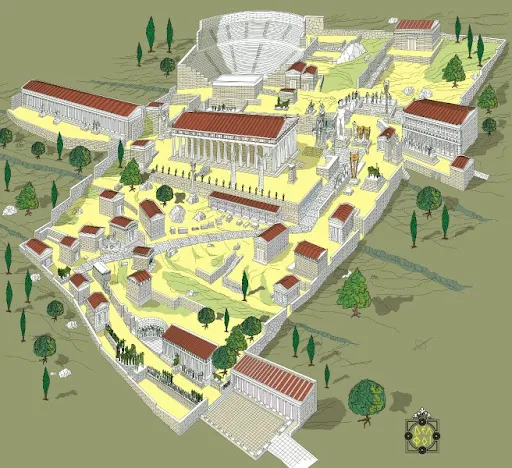Delphi - The treasury of the Siphnians
17) Treasury of the Siphnians
Period: 530 B.C.
The Treasury of the Siphnians is the most important in Delphi. It is dated precisely around 530 B.C., a truly prosperous period for the island of Siphnos, thanks to the gold and silver mines which were discovered there.
They dedicated the tithe of their income to Apollo at Delphi.
Sideview of the Siphnian Treasury
With an Ionian-like style, it was the first building made entirely by marble on Mainland Greece. It is among the finest monumental buildings in Delphi. The preserved decorative wealth are unique examples of Ionic architectural sculpture. The entrance of the treasury is located in the west, where was a small courtyard entoured by polygonal walls.
the Siphnian treasury - reconstruction by A. Tournaire
Two female statues - Caryatids* – between the pilasters replaced the columns of the gateway, according to the prototype of the Oriental temples.
The eastern and northern sides of the frieze were in an optimum place and could be seen through the entrance which was visible by the pilgrims ascending the Sacred Way. The stormy scenes of the Trojan War and the Gigantomachy * were considered to be the peak of archaic sculptures, as was the pediment with the Delphic legend of Heracles' dispute with Apollo over Pythia's divine tripod.
the East frieze of the treasury (exposed at the Archaeological Museum of Delphi)
the North frieze of the treasury (exposed at the Archaeological Museum of Delphi)
At the entrance of the imposing Treasure, which Herodotus describes as «immensely rich», a Delphian resolution was engraved in the 4th century B.C.:
DELPHOI APEDOKAN SIFNIOIS TAN PRO)MANTIAN ARXONTOS ARISTOMAXOY
which states that the Promanteia's * right was given to the island of Siphnos when the island was under the leadership of Aristomahos (in the 6th century B.C.).
Caryatid: is a sculpted female figure serving as an architectural support taking the place of a column or a pillar supporting an entablature on her head.
Gigantomachy one of the most popular myths in Greece, is the battles between the Olympian gods and Giants in antiquity. According to the myth, the Giants attacked the gods, but the Olympians learned that they could only emerge victorious if a mortal helped them. The gods therefore called Heracles to aid them, and they won the battle.
Promanteia: In the course of the classical period the priests of Delphi established a series of honours bestowed upon those who offered benefactions to the sanctuary, whether they were cities or individuals. The institution of promanteia was one of the privileges offered initially to cities which had offered aided the sanctuary financially. Promanteia was in fact the right to acquire an oracle before the others (yet still after the priests and the citizens of Delphi). Given the fact that oracle-giving was taking place on specific – and limited – periods of time, this right could actually be very important.
support us - buy the map!

The reconstruction poster map of Delphi,
by the Archaeological Guide of Greece
Poster size: 85X56cm / 34X22in
Designed and produced for a convenient and handy use in site and at home, it will assist you to visualize the Sanctuary of Apollo, where theOracle of Delphi was, the Ancient Theater, the Stadion, the Gymnasion of Delphi and the Sanctuary of Athena Pronaia.
price: 20€







